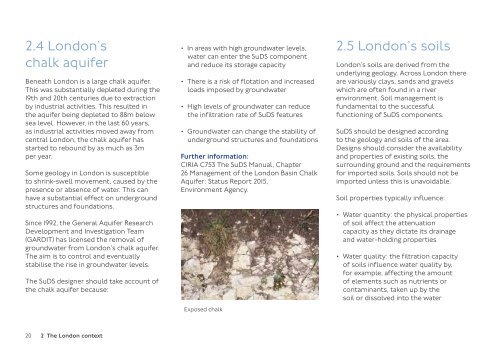SuDS in London - a guide
sustainable-urban-drainage-november-2016
sustainable-urban-drainage-november-2016
You also want an ePaper? Increase the reach of your titles
YUMPU automatically turns print PDFs into web optimized ePapers that Google loves.
2.4 <strong>London</strong>’s<br />
chalk aquifer<br />
Beneath <strong>London</strong> is a large chalk aquifer.<br />
This was substantially depleted dur<strong>in</strong>g the<br />
19th and 20th centuries due to extraction<br />
by <strong>in</strong>dustrial activities. This resulted <strong>in</strong><br />
the aquifer be<strong>in</strong>g depleted to 88m below<br />
sea level. However, <strong>in</strong> the last 60 years,<br />
as <strong>in</strong>dustrial activities moved away from<br />
central <strong>London</strong>, the chalk aquifer has<br />
started to rebound by as much as 3m<br />
per year.<br />
Some geology <strong>in</strong> <strong>London</strong> is susceptible<br />
to shr<strong>in</strong>k-swell movement, caused by the<br />
presence or absence of water. This can<br />
have a substantial effect on underground<br />
structures and foundations.<br />
S<strong>in</strong>ce 1992, the General Aquifer Research<br />
Development and Investigation Team<br />
(GARDIT) has licensed the removal of<br />
groundwater from <strong>London</strong>’s chalk aquifer.<br />
The aim is to control and eventually<br />
stabilise the rise <strong>in</strong> groundwater levels.<br />
The <strong>SuDS</strong> designer should take account of<br />
the chalk aquifer because:<br />
• In areas with high groundwater levels,<br />
water can enter the <strong>SuDS</strong> component<br />
and reduce its storage capacity<br />
• There is a risk of flotation and <strong>in</strong>creased<br />
loads imposed by groundwater<br />
• High levels of groundwater can reduce<br />
the <strong>in</strong>filtration rate of <strong>SuDS</strong> features<br />
• Groundwater can change the stability of<br />
underground structures and foundations<br />
Further <strong>in</strong>formation:<br />
CIRIA C753 The <strong>SuDS</strong> Manual, Chapter<br />
26 Management of the <strong>London</strong> Bas<strong>in</strong> Chalk<br />
Aquifer: Status Report 2015,<br />
Environment Agency.<br />
Exposed chalk<br />
2.5 <strong>London</strong>’s soils<br />
<strong>London</strong>’s soils are derived from the<br />
underly<strong>in</strong>g geology. Across <strong>London</strong> there<br />
are variously clays, sands and gravels<br />
which are often found <strong>in</strong> a river<br />
environment. Soil management is<br />
fundamental to the successful<br />
function<strong>in</strong>g of <strong>SuDS</strong> components.<br />
<strong>SuDS</strong> should be designed accord<strong>in</strong>g<br />
to the geology and soils of the area.<br />
Designs should consider the availability<br />
and properties of exist<strong>in</strong>g soils, the<br />
surround<strong>in</strong>g ground and the requirements<br />
for imported soils. Soils should not be<br />
imported unless this is unavoidable.<br />
Soil properties typically <strong>in</strong>fluence:<br />
• Water quantity: the physical properties<br />
of soil affect the attenuation<br />
capacity as they dictate its dra<strong>in</strong>age<br />
and water-hold<strong>in</strong>g properties<br />
• Water quality: the filtration capacity<br />
of soils <strong>in</strong>fluence water quality by,<br />
for example, affect<strong>in</strong>g the amount<br />
of elements such as nutrients or<br />
contam<strong>in</strong>ants, taken up by the<br />
soil or dissolved <strong>in</strong>to the water<br />
20 2 The <strong>London</strong> context


